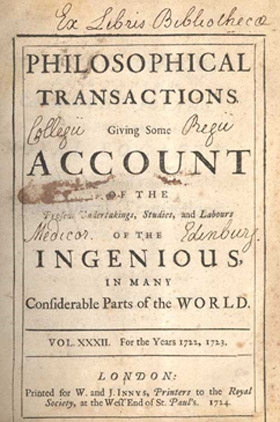On March 6 the scientific community will celebrate the 350th anniversary of the founding of the scientific journal. On that date in London, Henry Oldenburg, the first secretary of the Royal Society, an organization founded by Royal Charter less than five years earlier, began publishing the Philosophical Transactions of the Royal Society.[1] This publication looked remarkably like the present day scholarly journal—the format still recognized and used by the scientific community as the primary means of communicating scientific results.

The first issue of the Transactions was a bound collection of articles submitted by members of the Royal Society. The authors were largely physicians or “natural philosophers.” This latter title predated the emergence of the common use of the modern label of “scientist” by almost two centuries. The articles in the Transactions led off with an explanatory summary that we still call an abstract. This was followed by the main body of text, explaining the nature of the study and conclusions, often with included figures and annotated references. More remarkable than the constancy of the article format was the early establishment of the key benefits of a journal article, both for the authors and the reading community. These included: registration of the date of a scientific discovery, certification (peer review of the content before publication was granted), distribution of the printed volume as a means of disseminating the results well beyond the group of contributing authors, and archiving of the published content. These are all still considered the essential values of the journal today.
The first journal even had a business model that is largely intact to this day. Oldenburg was given a contract by the Royal Society’s president, Robert Boyle, to publish and distribute the journal at his expense with the incentive that he could keep any profits from the venture. Oldenburg was required to give free copies of the Transactions to all members of the Royal Society, but he was free to sell subscriptions to non-members, thus beginning the journal subscription model. Unfortunately, during the entire 12 years that he was publisher he never recovered his costs—a result typical of many entrepreneurial ventures. In fact, the journal never started to turn a profit until after 1948 when a significant number of institutional subscribers were attracted from international venues beyond the UK. The long gestation of the subscription model may contribute to its resilience, since this model is still the dominant source of income for the sustainability of scholarly journals. The Philosophical Transactions of the Royal Society still exists today as the oldest continuously published journal.
The original cataloging system of the Transactions, with articles bundled into issues and then into volumes, also remains the norm for many journals. However, different forms of journal articles have also appeared over its 350-year evolution, for example, briefer formats such as letters, which first appeared in the second volume of the Transactions, and extended formats such as review articles that sometimes make up entire journals. And virtually every field and subfield has an associated journal, as the number of titles has grown to its present volume of more than 28,000 titles in the English language published by more than 4,000 scholarly publishers. Throughout this growth of journals, the essential peer review process largely remains as it appeared in the first journal. There have been a number of recent experiments with post-publication peer review after articles are posted online as submitted, but these experiments don’t appear to have gained much traction for replacing the traditional system.
Even though the essential format of the modern journal remains similar to the original Oldenburg model, the migration of the format from print to the online environment has allowed the format to expand in utility. In particular, the innovation of reference tagging and article linking with attached “digital object identifiers,” pioneered by the CrossRef organization, is a significant boon to identifying and tracking articles. CrossRef’s present registry of online content exceeded 60 million articles last year, and the content grows by nearly two million new articles each year.
By moving away from the cost of a printed page, the expanded online format allows all sorts of added features to be associated with the basic article, from underlying tagging that again enhances discoverability of specific content in the article, to associated data and supplementary material to the primary journal article. These enhancements have helped, but not solved, the problem of how scientists keep up with the explosive amount of published content each year. It remains to be seen, 21 years after the first scientific journals went online, if the basic structure of the journal article will be deconstructed into a completely new format. Although that hasn’t happened yet, publishers and entrepreneurs in the trade continue to experiment with journal structures and related content to satisfy the demands of their authors and readers. I venture to say that the next few decades will bring significant change to this time-honored tradition of disseminating scholarly research.
[1] For a lively account of Henry Oldenburg and the first journal see: A. Singleton, Learned Publishing 2014, 27: 2–4 doi:10.1087/20140101.
